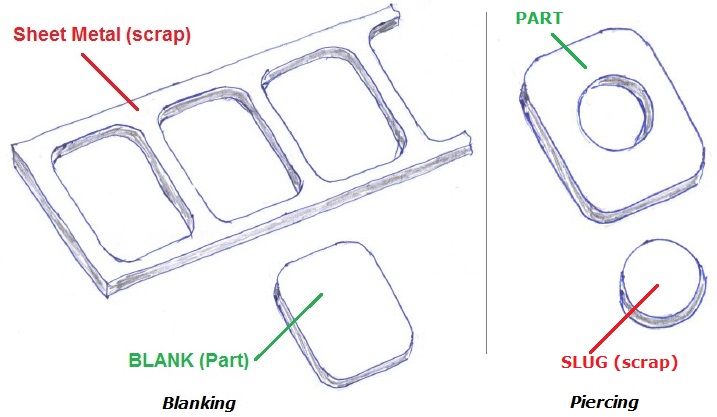Piercing is the operation of punching holes in the sheet metal. Both blanking and piercing are shearing operations. In case of piercing or punching, the material which is cut out from the sheet metal is scrap and the reining material is the actual part.
Difference between Blanking and Piercing

As I said earlier, both are metal shearing operations used for cutting sheet metal. The major differences are as follows:
- In blanking the portion of material which is cut out from the sheet is the required part.
Whereas in piercing the portion which is punched out from the sheet is scrap. - The blank dimension is determined by the die size. The pierced hole size is determined by the dimension of the punch.
- Hence, in case of blanking the die is made to the size of the required part and the cutting clearance is given on punch.
Conversely in piercing, the punch is manufactured to the size of the hole and clearance is provided in the die.
Other Piercing Techniques
These are variations of the piercing operation. Technically the cutting process is similar, but the resulting product will be different.
Lancing
Lancing is a partial cutting operation where bending and piercing is done using the same punch. In case of a rectangular profile, we can say that cutting 3 sides and bending the remaining would result in lancing. Please note that during lancing operation there is no slug and hence no wastage of material.
Shaving
Shaving is a finishing operation where a small amount of material is removed from a previously pierced hole. The shaving operation improves the quality of the hole and finish. Furthermore when we need to produce accurate holes with close tolerances, piercing and shaving is the way to go.
Cut-Off:
This is a form of piercing operation where the part is cut and separated from the sheet metal. For example in progressive dies, the final stage is often a cut-off station where the stamped product is cut and removed from the strip.
Parting-Off:
This is similar to cutoff operation. But the difference between parting off and cutoff is that, parting-off produces wastage of material. Depending on the shape of the contour, the wastage can be significant. However parting created two cut paths that can be different and hence are useful where cutoff can be performed.
Sheet Metal Piercing Tips
Clearance
Cutting clearance is an important consideration in piercing as well as blanking. As you already leaned cutting clearance in piercing operations are provided in the die. That means the piercing punch will be made to the required hole size and die will be bigger.
The amount of cutting clearance depends upon the type of material to be punched and the sheet thickness. Generally a per side clearance of 3% to 10% of the sheet thickness is used. The softer material requires less clearance and harder the material more the clearance needed.
It is important that the amount of cutting clearance required is calculated and provided correctly. This is essential to avoid excessive wear and tear, slug jamming and slug pulling which I will explain later in this chapter.
Piercing Punch and Die Material
The material used for punches and dies should have good ear resistance, compressive strength and temperature resistance. Consider these properties of the tool material along with the properties of the sheet metal to be cut and the quantity requirement.
Generally high carbon high chromium tool steels are used. The punch and die must be hardened and tempered to 60-62 HRC. In case of small sized punches that can break easily, HSS (high speed steel) is a better choice. Tungsten carbide is another material that works well where large quantities of parts need to be cut. This is because carbide can retain sharp cutting edges for longer period of time and can withstand higher temperature as well.
Slug Jamming and Slug Pulling
You will face these are two problems frequently during piercing or punching.
Slug Stacking or Jamming
This is a common problem especially while piercing soft and thin sheet metals.
The main reasons for slug stacking are excessive use of lubricant, too much land length in die and insufficient cutting clearance between punch and die.
The solutions include, providing the sufficient amount of clearance in the die. Reduce the amount of cutting oil or use a different lubricant that is less sticky. You can also try to decrease the land length so that the slug falls freely without getting stacked.
Also I would suggest you to provide angular relief in the die instead of counterbore relief. Because counterbore relief can cause slug tumbling that is caused by the falling at an angle from the edge of counter-bore relief.
Slug Pulling
Slug pulling is more serious problem. This is where the punched slug sticks on to the punch and comes out of the die. There are several reasons for slug pulling including excessive clearance, sticky lubricants, the shape of the cut profile etc.
However we now have several solutions for slug pulling. These includes providing shear angle on the piercing punch, adding a spring loaded ejector pin in the punch, using air blow through punch etc. In addition to that you can also use slug retainer die bushes and suction system to retain the slug inside the die.
I will write a detailed chapter on slug pulling and their solution in coming days.
Conclusion:
Piercing or punching is another useful metal stamping operation with wide applications. Although it is a simple technique, there are various factors to consider in order to carry out piercing effectively.
